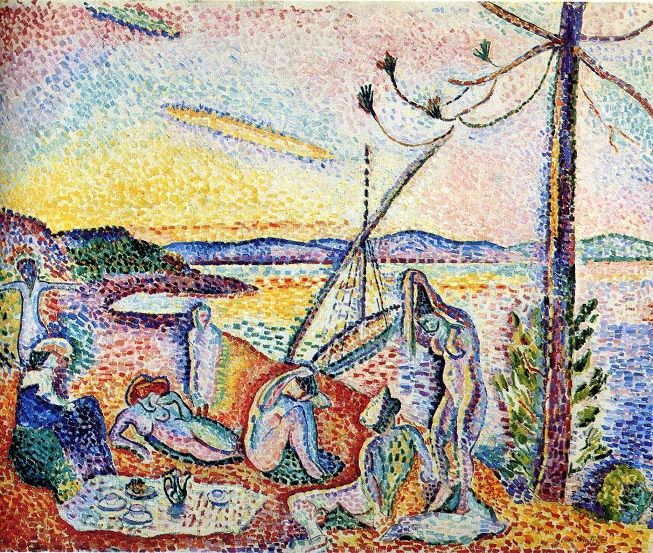Henri Matisse (1869 – 1954) was a famous French Post-Impressionist painter and sculptor. He is credited for several significant contributions to the world of painting during the modern art movement. Above all, he is remembered for his revolution of color that fueled much of the Fauvist movement.
Matisse’s paintings stand alongside the many interesting painters active during this period, and his artwork is comparable to practically any of the greats of the modern age. Furthermore, Matisse also introduced new ideas that would take hold and shape much of art in the following years.
When discussing Matisse’s paintings worthy of hanging on a wall, there are dozens of fantastic options within his collection of work. With so many beautiful and exciting paintings to choose from, it is hard to narrow it down to just a couple. Having said that, let’s get started!
The Joy of Life (1906)
If you want to know all about Matisse artist, look no further than his 1906 masterpiece, The Joy of Life. It is one of the most famous Matisse paintings and embodies all the art models and motifs that Matisse would become so well recognized for.
The Joy of Life, or Le Bonheur de Vivre as it was originally known, is considered by many as Matisse’s quintessential painting and is regarded as one of the founding paintings of the early Modernist movement at the start of the twentieth century.
Like many of Matisse’s most well-known paintings, The Joy of Life includes an abundance of color and an abundance of free-spirited nudity. Its Fauvist makeup and abstract composition would pave the way for the plethora of new styles that would emerge during this time.
Woman Reading (1896)
Woman Reading or Le Liseuse in French is one of the first successful Matisse paintings and is one of the only paintings remaining that the artist conducted in the style of Realism. At the beginning of his career, Matisse painted in a more traditional style and was exceptionally talented in classical techniques.
The Woman Reading is a beautifully tranquil and quaint oil on canvas painting. The woman sits with her back to us as she quietly reads in the comfort of what looks to be her living room. The painting gives off a warm and relaxing atmosphere. This is achieved by the subject matter itself and Matisse’s use of naturally inviting color.
As it was his first real breakthrough, it must have been a painting that Matisse, the newfound artist, was proud of. However, despite its success, Matisse would soon move away from the traditional realism style in favor of new ideas and his unique artistic vision.
The Dessert: Harmony in Red (1908)
Harmony in Red – Henri Matisse
By this time in his career, Matisse had been influenced by ideas from Impressionist artists such Vincent Van Gogh, Neo-Impressionist, Pointillist, and Divisionist artists Paul Signac and George Seurat’s color theory, and even Gustave Moreau’s models of Symbolism to a certain degree.
All of these influences and different ideas culminated in a radical change in the composition of Henri Matisse’s drawings and paintings. As a result, Matisse would craft his distinct and instantly recognizable style that would contribute to revolutionizing the art world.
His 1908 painting titled The Dessert: Harmony in Red is a prime example of Matisse’s quirky and unique style. The sharp color, ornate patterns, and abstract figurines are everything Matisse’s art stands for, and it is easy to see why many art historians and critics regard this painting as his most delicate masterpiece.
Les Toits De Collioure (1905)
The Collioure paintings represented a significant and pivotal period in Matisse’s artistic career. These colorfully abstract paintings would mark the French artist’s transition from a traditional style to the Post-Impressionism and Fauvist models synonymous with Matisse’s later work.
Les Toits De Collioure means the view from Collioure and is one of two paintings Matisse would undertake during his visit to the small coastal town. Les Toits De Collioure and Landscape at Collioure can both be seen as early experiments in what would soon become the Fauvist movement.
Fauvism was an artistic movement that focused on bold, exaggerated colors while at the same time retaining the realistic outline and dreamlike quality associated with the Impressionist movement. If you are interested in paintings that mark the birth of artistic movements, then definitely check out these early Fauvist Henri Matisse drawings.
The Sorrows of the King (1952)
The Sorrows of the King is one of the last paintings Matisse ever composed and thought by art lovers to be one of his best. It is a self-portrait of sorts; however, to truly call it a self-portrait is a stretch due to its wildly abstract nature.
Inspired by a painting by Dutch Golden Age master Rembrandt Van Rijn, Matisse devised this bright and vibrant masterpiece by cutting out shapes from sets of different colored paper and pasting them together into one wholly unique Abstract Expressionist collage.
With its festive atmosphere and party-like feel, The Sorrows of the King would mark the end of an extraordinary career with an explosion of vivacity and color. This successful and seminal piece, just like Matisse’s other successful and famous paintings, would leave a distinct stamp on the art world for generations to come.
Conclusion
Practically all of Matisse’s drawings and paintings have one thing in common. Despite their different themes, there is a common thread that runs throughout. This thread is one of awe and wonderment regarding life; ultimately, this positive outlook on life is one from which we could all take a page.



